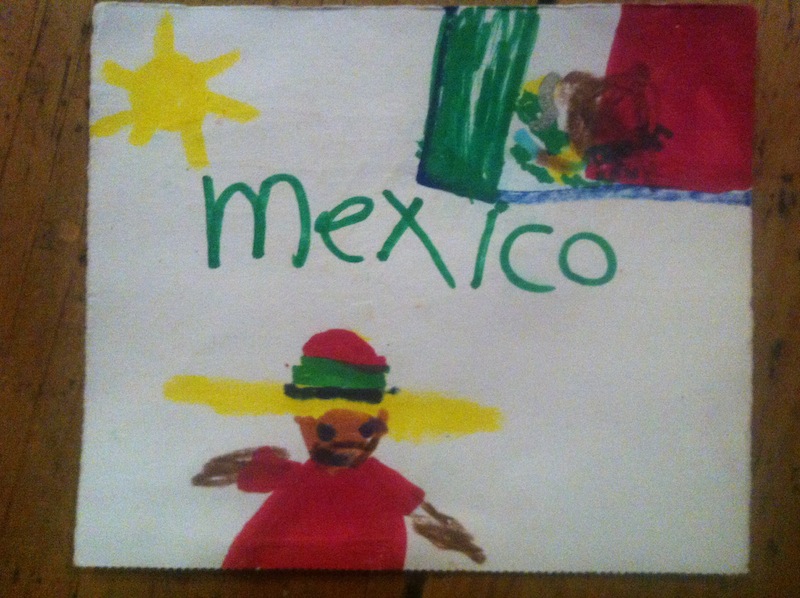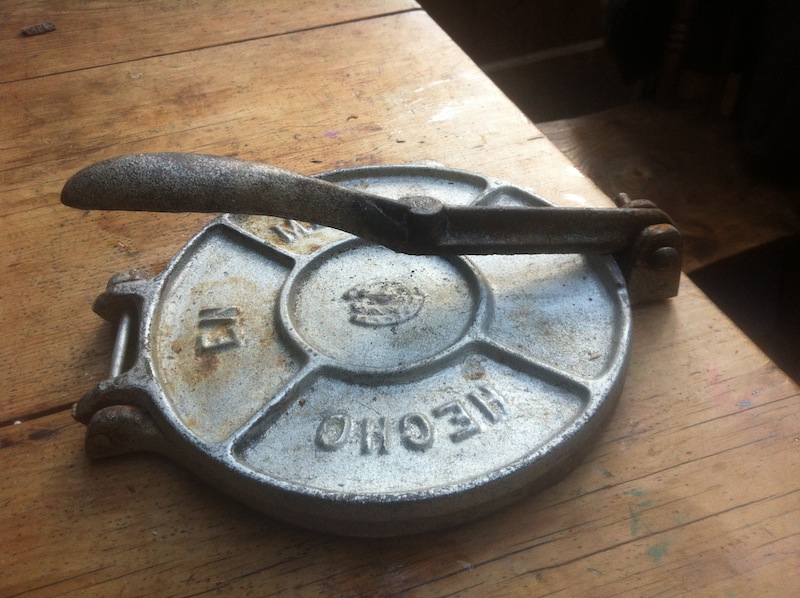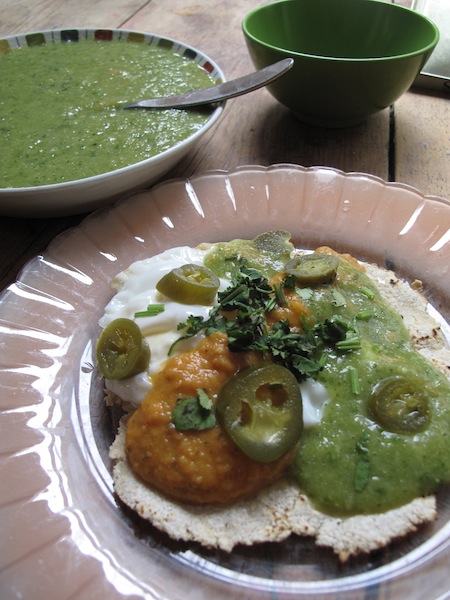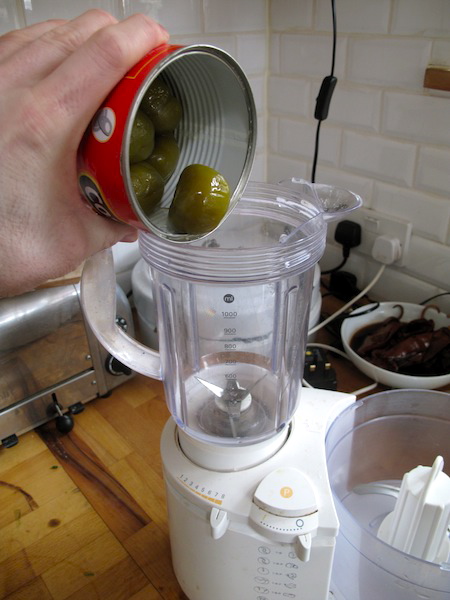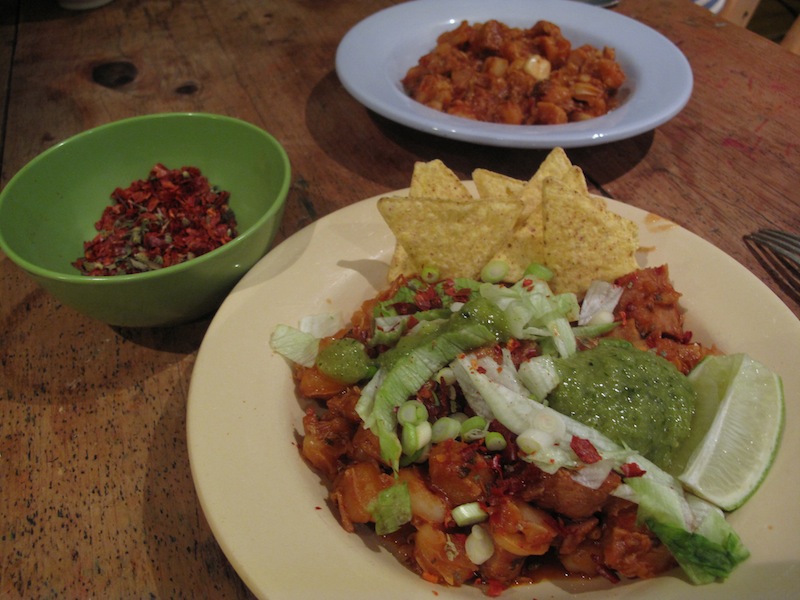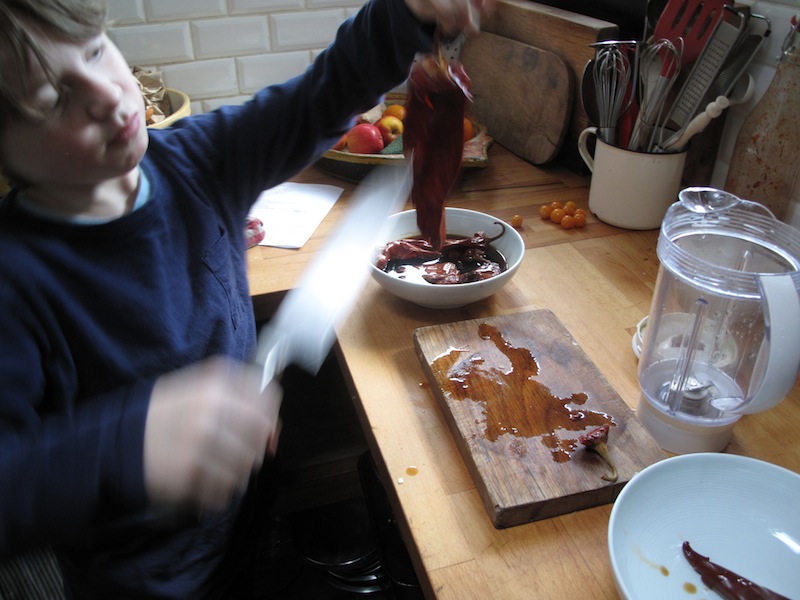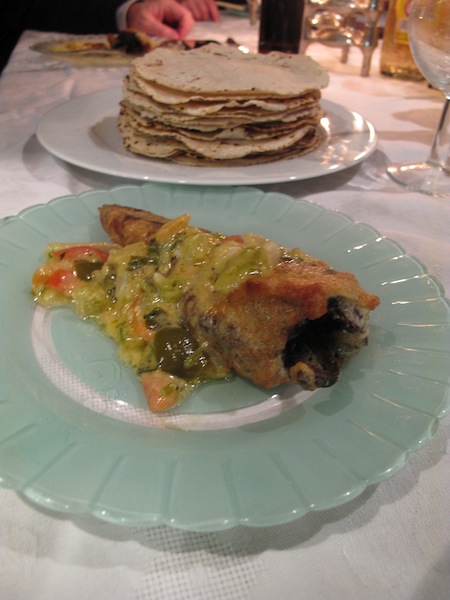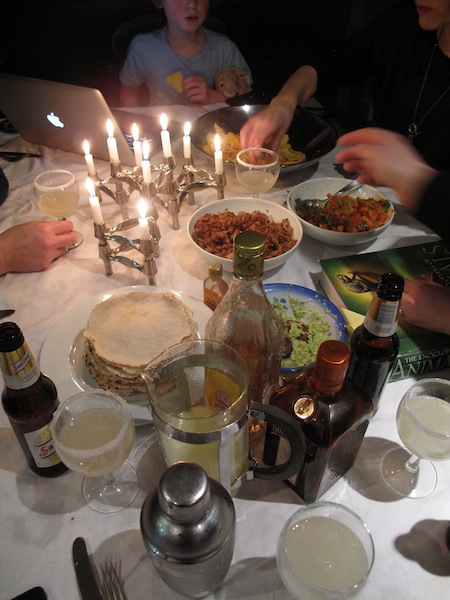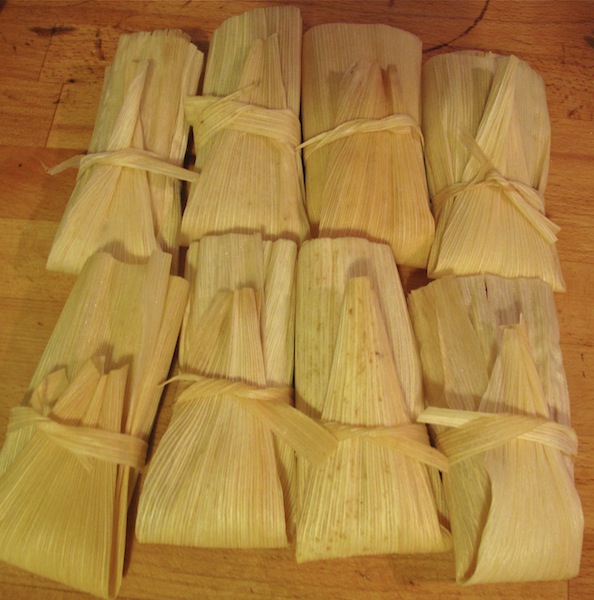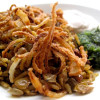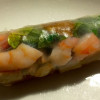After an – ahem – short absence we’re back with a biggie – Mexico.
There’s that old joke about Mexican food being just different ways of folding things – culinary origami if you will. Certainly the difference between a taco and a tostada, a burrito or a chimichanga is admittedly slight but each one has its own charms – a different type of tortilla, a different fold or some extra sizzle. And fillings, lots of different fillings. Oh and salsas… lots of salsas.
The Columbian Exchange – It’s Not A Drug Deal
It always amazes me to think that in Europe before 1492 there were no chillies (Thai and Indian food used pepper for spicy heat), no potatoes, no tomatoes, no chocolate, no maize, no turkey, no pumpkin. Or blueberry, passionfruit, peanut, avocado, sweet potato, vanilla, cashew and pineapple. Culinary life wouldn’t be worth living.
This momentous event in food history is known as the Columbian Exchange, and it allowed populations to increase around the world as new crops were available for the first time. One crop in particular has become a vital staple… and it’s not cocaine.
I have no interest in corny puns…
Before the Europeans arrived in the early part of the 16th century, maize was so important in Mexico and Central America that in some cultures they used the same word for mother and maize. Sacred for the Aztecs, nowadays more maize is grown in the world than any other grain – something like 690 million tonnes in 2012.
It’s an incredibly versatile crop – it was eaten raw, toasted and popped. As a flour (masa harina) it’s used to make tortillas, tacos, tostadas and even sometimes as a thickener in hot chocolate. Even the husks are used as a wrapper for tamales. That’s not to mention the high fructose corn syrup that makes its way into so many processed foods and that some believe to be singlehandedly responsible for the West’s obesity epidemic. Just sayin’.
It’s also used as hominy – a type of maize that is soaked and cooked in slaked lime. This stops the seed germinating in storage and helps the body absorb nutrients like niacin. I used this to make a type of stew called pozole.
Tortillas
If you’re going to try your hand at Mexican it pretty much starts with tortillas and to make authentic corn tortillas you need a tortilla press. Big producers have huge machines that churn them out – check out this one known as El Monstruo.
Mine is a lot smaller and, I’ll be honest, doesn’t get a huge amount of use – when I started this it was still encrusted with green playdough from one of my daughter’s play sessions a year ago.
Anyway, a tortilla press is great because it gets an even pressure on the small dough balls so, with a little care, you can get a nice round shape.
Corn tortillas are made with maize flour – masa harina – as opposed to flour tortillas which are made with wheat flour. Masa dough is quite crumbly and sticky so it’s difficult to use a rolling pin – hence the press. Conversely the flour dough tends to stick very badly to the tortilla press so it’s best to use a rolling pin.
Corn tortillas – recipe
Makes around 12 x 6in tortillas
450g masa harina (maize flour)
175-225ml warm room temperature water
Plastic bags, cut into squares – I cut mine to the size of the press
Method:
1. Add the water to the flour carefully until it forms a soft dough. If it’s too crumbly add a little more water, too sticky and add more flour.
2. While you’re making the tortillas, get a heavy frying pan on to a medium heat.
3. Pinch off a ball about an inch and a half in diameter. Put it in the middle of one of the squares of plastic and slide onto the bottom of the tortilla press then put the other square of plastic on top.
4.Close the press and push the handle down with a hard but even pressure. I found the best way to get an even shape without getting crumbly edges was to press down quite gently to start, then open the press, turn the dough 90 degrees, press again and repeat until the tortilla has squashed flatter. Then I was more heavy handed to get it squashed out to the desired diameter.
5. Carefully peel off the plastic and then peel the tortilla off and drop onto the hot pan. They only need about 1 minute on each side. Look for the edges drying out and then flip over. They sometimes puff up – this is good – and should look lightly toasted.
With a little bit of trial and error – and one or two burnt offerings – I managed to juggle one tortilla in the press with one in the pan. I made around 24 tortillas which was enough for breakfast and our Mexican dinner party.
Breakfast: Huevos Rancheros
Huevos Rancheros could be one of the best breakfasts known to humanity – it’s certainly a favourite in our house, at least for the grown ups. However, the kids were definitely unimpressed. Not sure if it was the chilli heat, the tortillas or just because they were being particularly fussy that morning. Hey ho! We soldiered on regardless and gave them marmite on toast instead.
Once you’ve made the tortillas there’s really nothing fancy about huevos rancheros but it really hits the spot if you’ve been on the tequilas the night before. I’ve been experimenting with the combination of egg and chilli recently – you can read more here.
Fry or poach your eggs then slide them gently on to warmed tortillas, smother with salsa and garnish with sliced fresh chillies or those nice pickled jalapeño slices, a little sliced red onion if you fancy and chopped coriander.
Serious Green – Tomatillos and Green Salsa
I used the leftover red salsas from our Peruvian cooking extravaganza along with a freshly made green salsa using tomatillos. Underneath their papery husk, these look like unripe tomatoes and are a little sharper, a little mealier than our “normal” tomatoes. They’re actually more closely related to the cape gooseberry than tomato – those little orange things that chefs used to garnish cheesecakes with about ten years ago.
Fresh tomatillos are difficult to get hold of but you can get the canned version from places like www.coolchile.co.uk. I used them for my stuffed chilli recipe (below) and for a green salsa that was excellent with the huevos.
Green Salsa
450g fresh tomatillos, quartered, or 450g can tomatillos
1-2 fresh hot chillies, such as jalapenos, chopped
1 small onion, chopped
2 cloves garlic, chopped
1tbsp chopped fresh coriander
salt and cumin to taste
1. If using raw tomatillos, quarter and place them in a saucepan with water to cover. Bring to the boil, then reduce the heat and simmer until soft but not too mushy, about 10 minutes. Drain gently, saving some of the liquid in case you need it for the salsa. If using canned tomatillos, do not cook, just open the can and gently drain.
2. Place the cooked or canned tomatillos in a blender or processor with the chillies, onion, garlic, and coriander. Blend until the mixture reaches the consistency desired: it may be preferred smoother or chunkier. Add a little of the cooking liquid if needed, for consistency.
3. Season to taste with salt and cumin.
A long wait for lunch…
Pozole is a traditional stew made with large maize kernels that have been soaked in lime – also known as hominy. Before you start cooking bear in mind this can take hours until the maize kernels are soft. It’s a flavoursome dish, and a great alternative to the standard chilli con carne but as with many Mexican recipes it’s the garnishes that make the dish.
I’m not ashamed to say that I used Dorritos as the “tortilla chip” element. Just as well as the kids didn’t like any of the rest of it and would have starved had it not been for those cheesy little crispy fellas.
I bought my pozole kit from www.coolchile.co.uk
Pozole Rojo – Ingredients
500g pozole/ dried maize kernels (cover with water and soak overnight)
500g diced pork
large onion finely chopped
1 whole bulb of garlic
60g chile ancho
20g chile guajillo
For the garnishing:
1 bunch radishes – sliced
½ iceberg lettuce – finely sliced
1 red onion, sliced
2 limes – quartered
10g chile de arbol – diced (came with the kit)
1 sachet of Mexican oregano (came with the kit)
1 packet of tortilla chips – Doritos!
Place the pre-soaked maize kernels and the bulb of garlic in a large pan with 3-4 litres of water – DON’T ADD SALT – it will make the kernels go tough. Bring to the boil, then lower the heat, partially cover and simmer for 4-5 hours, until the kernels are soft. That’s right – 4 – 5 hours – so if you want to eat this at a reasonable lunch time (as opposed to about 3 o’clock like we did) you need to get it on before breakfast.
In another large pan, add all the meat and just cover with water. Add 1tbsp of salt and bring to the boil, skim any froth from the top as you go. Add the half chopped onion to the pan, partially cover and simmer for about 2 hours, until the meat is tender. Turn off heat and allow the meat to cool in the liquid.
De-stem and de-seed the ancho and guajillo chillies. Place in a bowl and cover with just boiled water. Soak for 15 minutes, then puree the chillies with their soaking liquid, Check the maize pan, when kernels are soft sieve the chilli puree straight into the pan.
Add cooking broth to the maize and chilli pan with 2 tsp of salt, partially cover and simmer for another hour. Add the meat to the pan and heat through then serve with the garnishes.
Tequila vs. Mezcal
As Grimbaldino describes so succinctly in his post on tequila here, there are some myths about tequila that need to be dispelled. It’s not from a cactus but a lily called the Blue Agave and it doesn’t come with a worm in it – that’s Mezcal, which according to him anyway, is an inferior product, though I have to say after a couple of margueritas I couldn’t have called it.
Never one to shy away from the obvious, I plumped for the worm. Mezcal is made from the maguey plant – another form of agave – and originated from the drink pulque, the fermented sap of the maguey. Almost totally displaced by beer pulque has enjoyed something of a comeback in recent years but it’s virtually impossible to find in the UK – if someone can get some for me let me know as I’d love to try it.
When we were teenagers it was always thought that the worm was hallucinogenic and according to the literature attached to the bottle it may “unlock the door to a world of wondrous experiences”. The only experience I had was a massive hangover the next day and a deep sense of regret that I had been eating maggots.
Mezcal is drunk in the same way as tequila – neat, or with salt and lemon. Or sometimes with ground up fried larvae and chilli powder which sounds like a recipe for disaster.
Dinner: Chilli Relenos
I use big, dried chillies – in this case ancho, but sometimes pasilla or mulato. They’re packed with flavour but don’t have much heat so even for the biggest chilli wuss they’re a great starter dish. I like this recipe as it has a really interesting batter – light and airy. It’s almost like eating a bath loofah but in a good way.
Ingredients:
6 ancho chillies
For the filling:
300g tomatillos (or more tomatoes, or peppers) quartered
1 large onion, sliced finely
2 cloves garlic sliced
2 tomatoes, diced
250ml crème fraiche
200g medium Cheddar, grated
For the batter:
4 tablespoons of flour
3 eggs separated – you may need more
Oil for frying
- Soak the chillies in warm water for an hour or so.
- Pat dry then carefully slit them open and remove the seeds and membranes. Set aside while you make the filling.
- Heat a little oil in a frying pan and cook the onions until soft and starting to turn golden, add the garlic and cook for a couple of minutes.
- Add the chopped tomatillos and tomatoes. Cook for a few more minutes until the tomatoes are beginning to break down.
- Stir in the crème fraiche and season. Remove from the heat and set aside until you’re ready to cook the chillies.
- Stuff the chillies with cheese. Spread the flour on a plate and roll each chilli in the flour.
- Heat the oil in a deep fat fryer or wok to a medium heat.
- To make the batter, beat the egg whites until they form stiff peaks. Beat the egg yolks and fold in to the egg yolks a little at a time.
- Dip each chilli in the egg mix until well coated and then place carefully in the hot oil.
- The batter will foam up – they’re ready when the batter is golden and starting to brown. This should take a few minutes to allow the cheese to melt – if it’s too quick turn the heat down.
- Drain on kitchen paper.
- To serve – 1 chilli per person, cover with the reheated sauce and then garnish with fresh coriander.
Dinner: Carnitas
Which basically translates as “meat” or thereabouts. I wanted to go for a less obvious filling for my tortillas than bog standard chilli con carne so this delicious, slow cooked pork dish was a great alternative. As the name suggests it’s super meaty and massively flavoursome.
Ingredients
500g boneless pork shoulder cubed
2 teaspoons dried oregano
1 teaspoon ground cumin
1 tablespoon olive oil
1 onion, chopped
4 cloves garlic, minced
1 jalapeno, seeded and ribs removed, chopped (or other type of chilli to your taste)
1 orange, cut in half
3 tablespoons vegetable oil
Directions
Season the pork cubes and place in a saucepan. Mix in the oregano, cumin, olive oil, onion, garlic, and jalapeno. Squeeze over the juice of the orange and add the two halves. Cover and cook in the oven on a medium heat for 1 – 2 hours, checking regularly.
Once the meat is tender, remove from the oven and let cool slightly before pulling apart with a fork. In a large frying pan, add the vegetable oil and fry the meat until it starts to caramelise.
Pudding – Tamales
I don’t think I’ve ever eaten a Mexican dessert before and I have to say these tamales didn’t rock my world. They looked great though and as with most things tasted pretty good with loads of cream, sugar and rum poured over them. Definitely a special occasion type thing. Again, this recipe comes with the www.coolchile.co.uk tamales kit – next time I’m going to try the savoury version.
Ingredients
250g masa harina for tamales (mixed with baking powder)
60g corn husks – the wrappers
120g raisins
180g fat – we used Trex
150g sugar
1tsp salt
150g diced apple
1 tsp ground cinnamon
Method:
Soak the corn husks in hot water for 15 mins until pliable. Weigh out the fat and salt, place into a bowl and beat with until light and fluffy. Because I am a martyr to the culinary arts I eschew an electric mixer and used a wooden spoon but you’d honestly be better off with a food mixer.
Weigh out the sugar and add 1 cup of water to dissolve it, add the masa harina for tamales and mix into a dough.
Add the dough to the bowl of fat in three lots, beating it well in between until well mixed Set to one side.
Add the raisins, diced apple and cinnamon.
Line a steamer with baking paper, so that all the ends drape over the sides and can be folded over the top of the tamales, enclosing them completely.
Drain the corn husks and squeeze out any excess water. Rip one corn husk into 15 thin strips to use to tie tamales later.
One side of the husk is shinier and smoother than the other, this is the side you want to apply the dough. Place the husk on the work bench in front of you with the point facing towards you. With a spatula, fill a ⅓ cup measure with dough, level off flat and then scoop out on to the husk in the upper portion. You want at least a 2cm edge at the top, this allows for the tamal to rise. Do not spread the dough to the point of the husk. If your husk is too small, you can overlap two husks, this makes for trickier wrapping but you will soon get the hang of it.
Rolling & steaming tamales:
This is the tricky bit. Pick up the husk and touch the two outer edges of the dough together, the idea is to roll it off so that the dough encloses the filling and you get the filling running through the length of the dough. Roll the dough back and forth, then tuck one edge of the husk under the other and roll so it looks like a “cigarette” – one is assuming a special “jazz” cigarette – with a point at one end.
Take the pointed end and fold upwards, almost in half. Tap the tamal on its base to settle and tie with the corn husk strips. Place upright in the steamer, you will see the dough inside when look inside. Stack the remaining tamales inside so they are tightly packed and all standing upright.
Fold the baking paper over the tamales, cover with a tea towel and then the lid, bring to the boil and then turn down to a low simmer. Steam for approx. 1 hour. Keep an eye out – the water can boil dry and your tamales may end up as lumps of charcoal. If you need to top the water up add boiled water from the kettle.
When the tamales are done you should be able to peel the wrapper away cleanly and it will be springy to the touch. According to the Cool Chile recipe, you can eat them straight away but apparently they are even better the next day – just re-steam until they’re hot.
Stockists:
For my Mexican day, Cool Chile were virtually a one stop shop and I felt like a little bit of a cheat getting absolutely everything from them. However, I’ve been buying from them for years and I think their stuff is great.
www.southdevonchillifarm.co.uk
These are local to us here in Devon and I used their ancho chillies for my stuffed chilli recipe. They also have a very nice cafe where you can get a cracking Quesadilla.
I used these guys for the post on Peru but the Aji Panca and Aji Amarillo chillies featured heavily in the salsas I made for our Mexican dinner.
